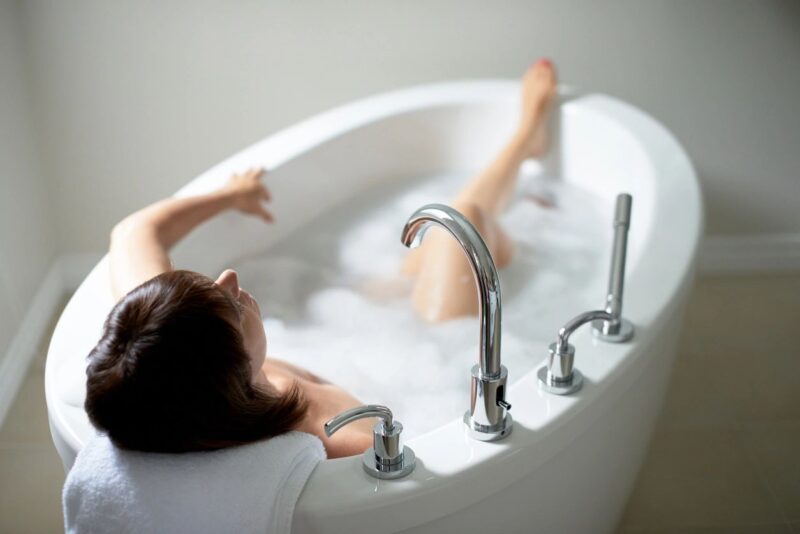It’s essential you choose the right tub when building a new house or planning a home remodeling project since having a clean and suitable bathtub is a requirement, especially if you’re looking forward to a soak after a long day at work.

When it comes to picking a bathtub, there is a lot of information to go through, and it might be intimidating if you don’t know where to begin. Before you go to install a bathtub on your next plumbing job make sure you have insurance for plumbers to cover yourself and your work. Here’s our quick and simple guide to bathtubs that should help you understand how they function and how to pick the best one for your next job.
How do bathtubs function?
While there are many shapes and designs of bathtubs available today, they all function on the same premise of using a water supply and a drain. They are commonly made of porcelain-enamelled steel, thermoformed acrylic, or fibreglass-reinforced polyester.
The tub, the water supply line, and the drain are the three primary components of a bathtub. Valves are connected to hot and cold water supply lines, whereas drains are connected to the bath’s drain line. Water is added to the bath via the taps, remains in the tub while the plug is in place, and exits through the drains when the plug is removed.
What are the benefits and drawbacks of bathtubs?
Bathtubs are fairly prevalent, but before you choose a bathtub for your home, you should consider whether or not you need one. Here are some of the benefits and drawbacks of bathtubs to assist property owners and investors in making an informed decision as to whether to install a bathtub.
Advantages of bathtubs
Muscles are soothed by taking a bath: Sore muscles can be relieved by taking a bath, especially if you add Epson salts to the water, which are used to exfoliate and soothe the skin while also reducing inflammation in the joints.
A bath can help you relax and decrease your blood pressure: Baths may be aromatherapeutic when essential oils are used. Bathing with essential oils can help to relieve tension and anxiety, as well as alleviate gastrointestinal difficulties, aches, and general stress levels in the body. It can also help to lower blood pressure. Baths may have a variety of beneficial benefits on the body depending on the essential oils used.
Baths are great for kids: It is simpler to clean children in tubs than it is to clean them in showers. Bathing in tubs is not only more pleasant, but it also provides an opportunity for youngsters to play. In addition, baths can help calm children after a long, busy day.
Some baths offer special features: Property owners can add whirlpools or air jets to baths, depending on their preferences. These improvements not only make bathing more pleasant but also bring a sense of elegance to bathing at home.
Disadvantages of bathtubs
Accessibility for persons who have difficulty moving: Because of the form tubs typically take, whether freestanding or inset, older individuals may find it difficult to get in and out of them. Bathtubs are extremely slippery, which means that older persons who are unsteady on their feet are more likely to slip and fall. Consider a tub with better accessibility or handle grips along the wall if you’re building a tub for someone who might find it difficult to get in or out.
Water use is high: Bathtubs may carry anywhere from 50 to 150 litres of water, and sometimes even more. Bathtubs, therefore, may not be an appropriate bathing option for those concerned about water conservation.
It will take some time to take a bath: Bathing can be time-consuming… which may be a good thing! Filling a tub and emptying it after bathing requires time, in addition to the actual bathing operation. Showers would be more useful if you needed to get washed quickly.
What materials are most commonly used to make baths?
When it comes to selecting bathtub materials, there are several alternatives. Each of them has its own set of benefits and drawbacks, which we’ve mentioned here. The following are some of the most frequently used bathtub materials:
Fibreglass
Fibreglass is a sort of reinforced plastic that has been layered and moulded into a bathtub shape. After achieving the required form, the fibreglass is covered with gel coat resin to preserve it and restore its original appearance.
Pros: Fiberglass bathtubs are among the most cost-effective options available. For those on a low budget, this tub is a wonderful choice. Fibreglass is a relatively light material that can be readily moved into a property. It is also relatively straightforward to repair if it is damaged.
Cons: This material is porous and prone to breaking over time, and the finish and colour of the tub may deteriorate in response to the use of cleaning chemicals.
Acrylic
Acrylic tubs are made by heating and moulding a solid sheet of mixed ingredients (resins, fillers, petrochemicals, stabilisers, and so on) into the shape of a bathtub. Acrylic is then strengthened with fibreglass.
Pros: Unlike plain fibreglass, this material is not porous. It is less likely to be destroyed over time since it does not absorb water. Porcelain tubs lose heat faster than acrylic tubs. This material is also less prone to stains and mildew in the bathroom.
Cons: Acrylic is prone to scratching, and stepping on it may make you feel unsteady. The cost of this material is also higher than that of fibreglass tubs.
Porcelain
This tub is built of pressed steel or cast-iron components that have been covered with porcelain enamel material that has been fused via powdered glass, melted at high temperatures, and hardened into a durable covering.
Pros: Porcelain baths are glossy and smooth. They are scratch-resistant and simple to clean.
Cons: Porcelain baths are slick due to their high shine and lustre. Porcelain baths are therefore a tripping danger. Furthermore, because porcelain does not retain heat efficiently, hot water temperatures in this style of tub will not be maintained. Porcelain tubs are prone to chipping when hit hard; therefore, use caution when using this style of tub.
Ceramic
Ceramic clay is fired at a high temperature until it solidifies, resulting in bathtub-shaped ceramic tiles.
Pros: This is simple to mould and works with a wide range of characteristics. Bathtubs made of this material come in the widest range of sizes and shapes. In comparison to other materials, it is also easy to style. Ceramic tubs are also one of the most cost-effective choices available.
Cons: This material requires more regular upkeep. Maintaining the grout that holds the ceramic tiles together is critical; otherwise, the material can crumble and deteriorate. This substance may also have an uneven or rough texture.


